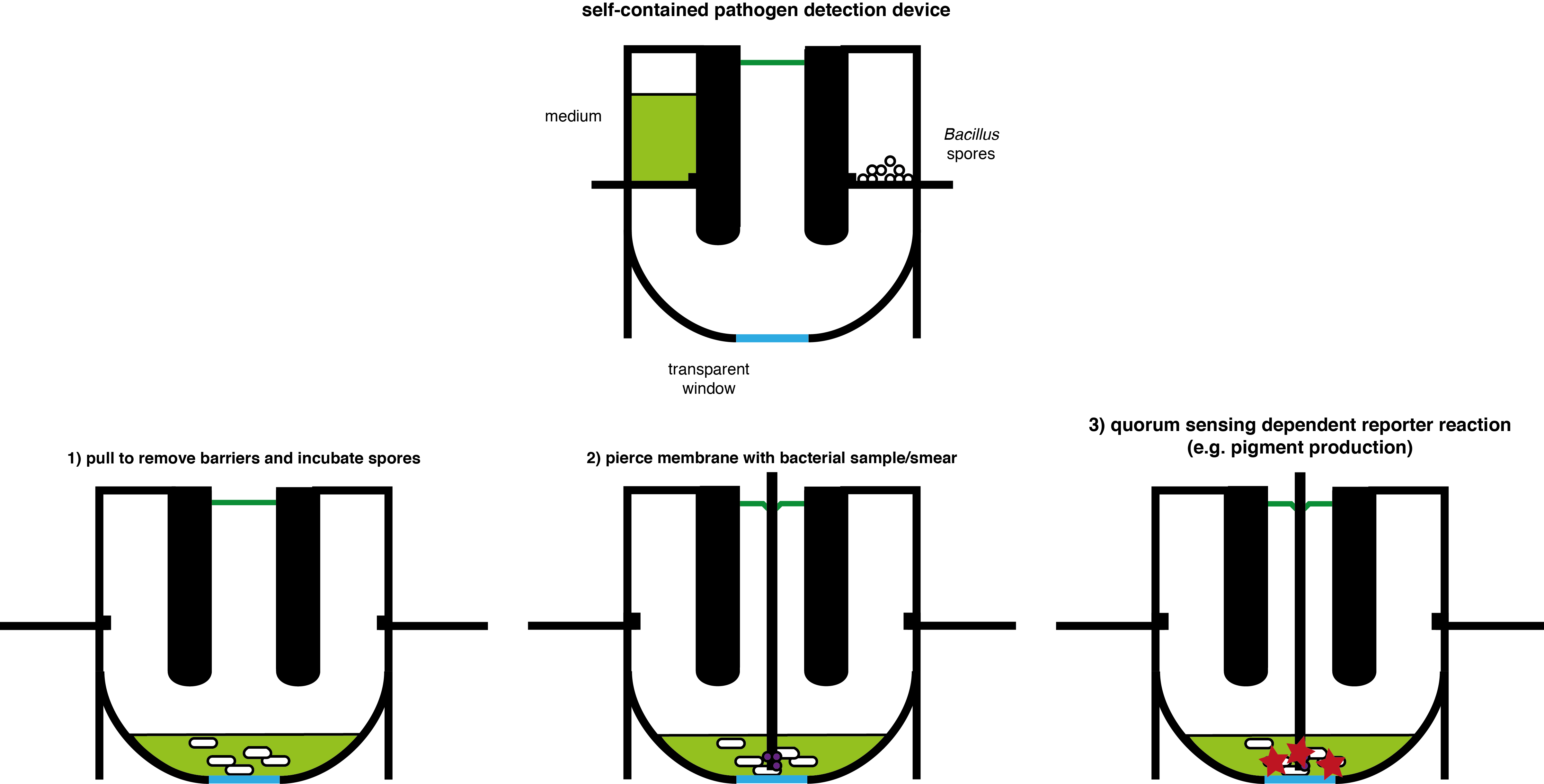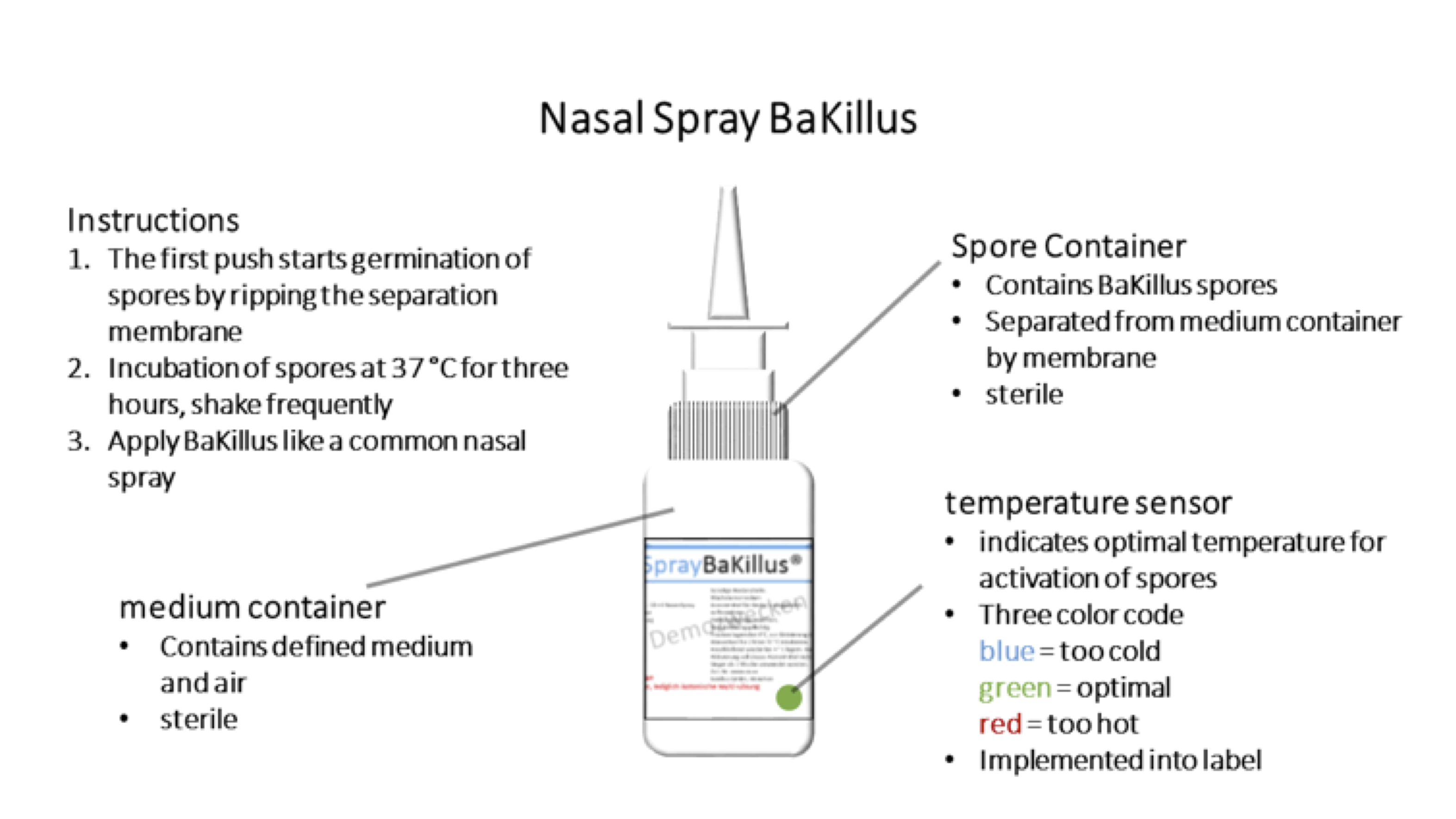Team:LMU-Munich/Rathenau
From 2014.igem.org
Hoerldavid (Talk | contribs) |
Hoerldavid (Talk | contribs) |
||
| Line 1: | Line 1: | ||
| - | {{Template:Team:LMU-Munich/ | + | {{Template:Team:LMU-Munich/Playground/menu}} |
| Line 106: | Line 106: | ||
| - | {{Template:Team:LMU-Munich/ | + | {{Template:Team:LMU-Munich/Playground/footer}} |
Revision as of 19:37, 16 October 2014
Collaboration with the Rathenau Institute
Application Scenario
Download our application scenario as a PDF here.
The BaKillus Concept
Increasing bacterial resistance to classical antibiotics remains a serious threat and urges the development of novel pathogen-killing strategies to treat infectious diseases. Exploiting bacterial communication mechanisms such as quorum sensing is a promising strategy to specifically target certain pathogens. Towards this goal, the synthetic organism BaKillus was designed to specifically target respective QS-dependent pathogenic bacteria. Here, the core element is a pathogen-detection device to detect Staphylococcus aureus and Streptococcus pneumoniae. By utilizing QS-dependent promoters, BaKillus will activate pathogen-killing devices like the production of antimicrobial peptides or biofilm degrading enzymes in the presence of target pathogens (see Fig. 1 for details). As a safety measure, a delayed suicide-switch guarantees non-persistence of genetically modified B. subtilis in the absence of pathogens.

Application
BaKillus could be applied in two independent ways, first as a point-of-care diagnostic tool to identify pathogens and second, as a drug-producing microbe to treat bacterial infections.
Pathogen-identification diagnostic tool:
Problem:
Current tests to identify S. aureus (e.g. coagulase) require a time-consuming (18-24h) culturing step.
The BaKillus S. aureus diagnosis tool:
If the S. aureus detection device is sensitive enough, a smear of a patient into the BaKillus diagnostic tool would be enough to verify a S. aureus (MRSA) infection. This culture-independent detection provides results within 1-2 hours (just limited by the time for BaKillus spore germination and gene expression) and subsequent treatments could be initiated more quickly. We are planning to develop a ready-to use diagnosis tool for point-of-care testing by the professional staff in hospitals, pharmacies or medical offices (see Fig. 2). We are looking into collaboration with the iGEM-Team Aachen, who are planning something similar (https://2014.igem.org/Team:Aachen).

| Strengths | Weaknesses |
|---|---|
| Detection & Identification of AIP dependent pathogens | Application is limited to targets that exhibit QS-dependent pathogenicity. |
| Initial assessment of the sensitivity of the test and tests for reliability of the tool required | |
| Self-contained/tightly closed device prevents release of GMO and thus a product possibly has little legal barriers for approval. (This is topic of an ongoing discussion with Dr. Ulrich Ehlers (Commissioner for GMO-release in Germany, BVL) and Dr. Hans Schrubar (Commissioner for Bio-Safety in Bavaria) | |
| Easy engineering and handling of the detection devic | Maybe too cost-intensive due to the need of high-end technology for measurement, especially for the utilization in developing countries. We seek to minimize this hurdle by using low-cost hardware (e.g. Raspberry Pi instead of a conventional computer). |
Pathogen treatment tool:
Problem:
Unreasonable use of antibiotics reinforces the propagation of bacterial resistance and globalization of the failure of classic antibiotics to treat bacterial infections.
The BaKillus pathogen treatment tool:
Based on the pathogen-detection device, BaKillus will activate its pathogen-killing devices (see Fig. 1) to kill S. aureus or S. pneumoniae. Both are often associated with surface infections of the human body system and thus BaKillus could be used to cure infected patients. We discussed potential applications with doctors and immunologists and plan an application as a nasal injection to treat chronic inflammation of the ENT tract.
| Strengths | Weaknesses |
|---|---|
| Novel antibiotics allow treatment of resistant superbugs like MRSA | Unknown efficiency and interaction of the drugs with the human body system, therefore individual evaluation and approval required for each novel antibiotic. |
| Local treatment dependent on presence of pathogen => no need for broad spectrum-antibiotics | |
| Combination of drugs allows effective killing and little survival of resistant subpopulations | Strong legal regulations to use GMOs on humans could make the approval a long endeavour and obstruct the substitution of sensing and killing devices for personalized needs, as individual approval is required. |
| Low production costs | Immense costs to fulfil legal regulation for approval and clinical studies |
| Bacillus subtilis is Generally Recognized As Safe (GRAS status, FDA), so BaKillus is probably non-pathogenic. Additionally, the Suicide Switch and the Trytophane auxotrophy add addtional safety layers. |
The gene safety discussion:
Using GMOs for any kind of application requires a detailed consideration about risks and legal regulations. The diagnostic tool does not release the GMO and the approval might be feasible in near future, whereas the use of BaKillus as a nasal spray faces huge legal barriers to be overcome and is unlikely to come into the market in the near future. Necessary steps (timeline) and legal regulations (paragraphs) for an approval of both products will be part of our application wiki. We are in an ongoing discussion with Dr. Ulrich Ehlers (Commissioner for GMO-release in Germany, BVL), Dr. Hans Schrubar (Commissioner for Bio-Safety in Bavaria) and Dr. Gabriele Wanninger (Expert for clinical studies in Bavaria).
Realisation:
In view of the possible BaKillus application process, we first plan to focus on the development of the diagnostic tool inside the university. Funding might be possible by DFG or SynBio- or entrepreneurship-funding organizations. Once our idea is able to leave the lab, we would start a business and develop a prototype with the help of an industry partner (e.g. a small engineering company) and venture capital funds. Alternatively, we would look into the possibility of acquiring the necessary financial means through a crowdfunding campaign. Throughout the development process, we would apply rapid prototyping techniques such as 3D printing to quickly reach a market-ready product. At the same time, intellectual property (e.g. patents) will be built up to protect our invention and provide an income for the growth of our start-up. Through the success of our diagnostic tool, we can convince further investor and finally could be able to afford the approval process of the BaKillus nasal spray. Once we have brought this product to the market, we can push for new legal regulations regarding the approval of SynBio products.

Hi there!
Welcome to our Wiki! I'm BaKillus, the pathogen-hunting microbe, and I'll guide you on this tour through our project. If you want to learn more about a specific step, you can simply close the tour and come back to it anytime you like. So let's start!

What's the problem?
First of all, what am I doing here? The problem is, pathogenic bacteria all around the world are becoming more and more resistant against antimicrobial drugs. One major reason for the trend is the inappropriate use of drugs. With my BaKillus super powers, I want to reduce this misuse and thus do my part to save global health.

Sensing of pathogens
To combat the pathogenic bacteria, I simply eavesdrop on their communication. Bacteria talk with each other via quorum sensing systems, which I use to detect them and trigger my responses.

Adhesion
The more specific and effective I can use my powers, the lower the danger is of provoking new resistance development. So I catch pathogens whenever I get hold of them and stick to them until my work is done.

Killing
Talking about my work - killing pathogens is finally what I am made for. In response to quorum sensing molecules of the pathogens, I export a range of antimicrobial substances leading to dissipation of biofilms and the killing of the targeted bacteria.

Suicide switch
When the job is done and all the bad guys are finished, you don't need a super hero anymore. So after fulfilling my work I say goodbye to the world by activating my suicide switch.

Application
Of course I'm not only a fictional hero, but a very real one. In two different prototypes, I could be used for diagnosis or treatment of pathogen-caused diseases. However, there is still a whole lot of regulational and economical questions that have to be answered before.

See you!
So now you know my short story - and it is time for me to return to my fight for a safer world. Feel free to take a closer look on my super powers, the process of my development or the plans for a medical application.
 "
"







